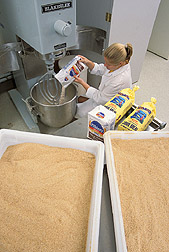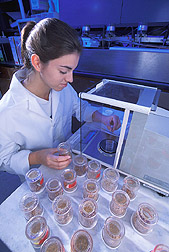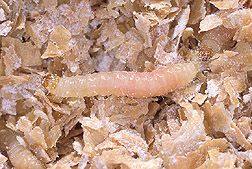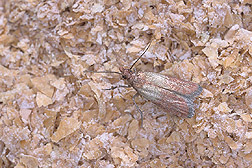Scientists Try to Stop Cereal Killer |
|
 Chemist Donald Silhacek (left) and technician Curtis Murphy monitor distribution and movement of Indianmeal moths in a model warehouse as part of a commodity-infestation study. In this test, the effects of different light colors and durations are tested on moth development, movement, and reproduction. (K10312-1) |
Have you ever opened your cupboard door only to be greeted by a fluttering moth? Has your morning ever been ruined as you pour milk on your favorite breakfast cereal and, through sleepy eyes, spot small critters doing the backstroke in your bowl? If so, you'd probably recognize the Indianmeal moth, Plodia interpunctella, the leading pest in stored feed, food, and seed. This tiny insect with gray and reddish-brown wings is generally recognized in the United States as the most prevalent and damaging pest in stored commodities. Infestation of cereal products by the Indianmeal moth and its larvae is a major problem for the milling industry. Cereal grains aren't infested when they are processed. But products can become infested later, during transport and storage at retail outlets or in the home. |
 Test diets for Indianmeal moths being prepared by student assistant Amy Terrill. (K10311-1) |
Chemist Don Silhacek and lab technician Curtis Murphy at ARS' Center for Medical, Agricultural, and Veterinary Entomology (CMAVE) in Gainesville, Florida, are seeking safer methods to eliminate or reduce use of conventional pesticides for protecting stored food products. Traditional pesticides used to protect cereal grains during transport and storage, such as methyl bromide, are being eliminated because of concerns about harmful effects on humans and the environment. Scientists in CMAVE's Postharvest and Bioregulation Research Unit want to find alternatives to pesticides that work and make sense economically. Their studies have focused mainly on protecting processed cereal-grain products by using the infesting moths' own behavioral and physiological responses against them. Cereal products become infested when females lay hundreds of eggs directly on the product or when newly hatched larvae crawl into the product. But a cereal must have the appropriate nutrients for larval growth to make the infestation successful. According to Silhacek, the growth rate of Indianmeal moth larvae can vary widely, depending on the nutritive and physical qualities of a processed cereal product. |
 Student assistant Laura Parenteau checks the growth rate of Indianmeal moth larvae on test diets. (K10314-1) |
"During our studies, we observed that some popular cereal products were not susceptible to Indianmeal moth infestation," Silhacek says. " Though the products were considered nutritious for people, they did not support growth and development of the moth. We are currently identifying some of the factors that naturally limit moth development on cereal grain products. Our goal is to help design cereal products that are appealing to people and animals but are not susceptible to moth infestation." In a second approach, two model warehouses with adjustable environments are being used to identify external factors that affect moth behavioral and physiological responses during cereal product infestation. The researchers developed unique methods to identify and explore some of these factors. For example, the moths' movements in a warehouse during a 96-hour test infestation period were determined by plotting their positions on a grid every 4 hours. The scientists manually counted the moths on selected grid squares, each 12 inches by 12 inches. |
 Larva of Plodia interpunctella, commonly known as the Indianmeal moth, a major pest of processed cereal products in the United States. (K10313-1) |
The scientists found that moth behavior during the infestation is regulated and synchronized by the light-dark cycle, or photoperiod. Adults emerge from their cocoons only during the last few hours of light. Newly emerged moths scurry to the nearest vertical surface, such as a wall, until their cuticles harden. The insects mate, and then mated females move during the dark period to pallets where cereal products are stored. When daylight returns, the females become quiet while the males fly upwind, coming to rest on the face of the circulating-fan housing. These patterns of female movement during dark and male movement during light continue each day of the infestation period. Research is ongoing to determine whether commodity infestations can be managed by modifying the photoperiod and by substituting different wavelengths of light into the photoperiod. |
 Adult moth of Plodia interpunctella, commonly known as the Indianmeal moth, a major pest of processed cereal products in the United States. (K10313-2) |
"No one thing is going to be the linchpin," Silhacek explains, " but if we can incorporate several of these negative environmental factors into a comprehensive plan for protecting cereal products, the cumulative effect would be better, safer moth management in warehouses and retail markets." A third approach the CMAVE scientists are taking to limit or eliminate pesticide use is to gain a better understanding of juvenile hormone agonists—substances that mimic the action of the hormone. Juvenile hormone (JH) first appears late in embryogenesis, or egg development. Later, high levels function to keep insects in the larval stage. When JH levels decline, larvae pupate and then transform into adults. Later, JH reappears and assumes a function in reproduction. If used at certain times, JH agonists can prevent pest insects from developing normally into adults. Silhacek and a colleague, Susanne D. Dyby, formerly a postdoctoral scientist with the research unit, found that briefly exposing a moth embryo to the JH agonist pyriproxyfen very early in development caused defects that led to embryo death. Pyriproxyfen can be applied to surfaces and delivered to the egg directly or via the female's feet. This basic knowledge helped the researchers design more effective protocols using JH agonists to manage moth populations, significantly reducing product damage. Silhacek found that effective control could be achieved with less pyriproxyfen by strategically placing it on surfaces frequented by moths, such as warehouse walls and the outer cartons containing the packaged products. A single application of the agonist, at a relatively low concentration, can effectively protect freshly processed cereal products from Indianmeal moth infestation in a model warehouse for as long as 1 year.—By Jim Core, Agricultural Research Service Information Staff. This research is part of Crop Protection and Quarantine, an ARS National Program (#304) described on the World Wide Web at www.nps.ars.usda.gov. Don Silhacek is with the USDA-ARS Postharvest and Bioregulation Research Unit, Center for Medical, Agricultural, and Veterinary Entomology, P.O. Box 14565, Gainesville, FL 32608; phone (352) 374-5758, fax (352) 374-5703. "Scientists Try to Stop Cereal Killer" was published in the May 2003 issue of Agricultural Research magazine.
|






